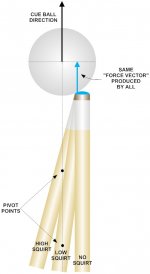LD Shafts
Roger,
I see your point and agree with 90% of what you say. Less english, less complication, more better. I play 8 ball on bar tables (only game in town normally) so my experiences are tied to bar table 8 ball. I play area shape (i.e., an place on a decent line to the next shot, not blocked by a ball). I think it slightly foolhardy to play to a specific spot if you don't know if the table and balls are in good shape, so I'm happy with windows rather than spots. As I said, I like to play a little outside english if possible for the consistency, but I don't mind warping the ball if needed to get the throw I want or leave I want. I don't consider myself a great follow/draw shot player, but I get by with both. Larry N. has nothing to fear from my stroke

I have won team matches with goofy english off the rail, I'm generally pretty adventurous rather than conservative. I see english and top/bottom as essential to 40-50% of my shots (wild guess).
I like the LD shafts because they don't cost you anything as far as accuracy on easy shape shots, but they greatly help on spin shots. If you need to spin a ball in off the rail, it is nice to know you can aim at the spot with inside english and get the right spot rather than compensate for english squirt.
Just talking one-rail kicks, it is sometimes easier to kick with 1 or 2 tips side rather than centerball, and I find it less cumbersome to use a LD shaft to hit the spot I want than a standard shaft. Freddy's books and the big yellow 8 ball book (Robin Givens?) have some great 1 rail kick with english systems.
I'm partial to the OB Classic shaft on our league Valley Tables, but liked the Jacoby Hybrid shaft much better on the diamond tables at vegas. I don't know for sure what that means about the difference between the shafts, if that makes sense to anyone and can explain it to me, I'd love to hear it.
I'm intrigued by your assertion that squirt is much worse with below-center hits and want to look into that further. Is it not normal to have 2-3 ball squirt on a full table kick using any side?
I have no magical unreaslistic expectations with LD shafts or cues in general, I like the ones that send the ball in the right direction.
I'll try to keep this simple.
I believe in using english (meaning side-spin, only) whenever, and wherever, it is necessary in order to move the cue ball to a certain spot after it rebounds off a cushion. I also believe in using as much, or as little, english as is necessary to get the exact angle I need off of a cushion. I never use it to try and steer the cue ball before contact with the object ball unless I purposely employ a downward stroke with it.
I believe that cue ball deflection ("squirt") is something I have to deal with any time I hit the cue ball with english (meaning side-spin, only) on, or below, the horizontal axis with a firm stroke. I also believe that cue ball deflection is not something I have to deal with when I hit the cue ball with english (meaning side-spin, only) above the horizontal axis with a medium, or soft, stroke.
I believe that "low-deflection" shafts could lower the amount of cue ball deflection I might experience when hitting the cue ball with english (meaning side-spin, only) on, or below, the horizontal axis with a firm stroke; however, existing tests have shown that the actual amount of reduction achieved is not enough to entice me into paying a high price to acquire one, or interest me in spending any time to adjust to one.
I believe that robotic tests could be set up that would demonstrate my claims concerning the "above horizontal axis" hit. I also believe that all "low-deflection" shaft manufacturers would readily disagree with those same claims.
Roger

